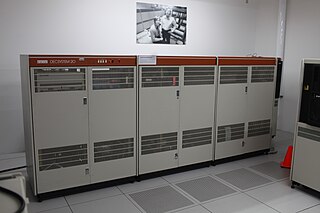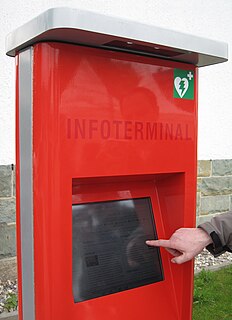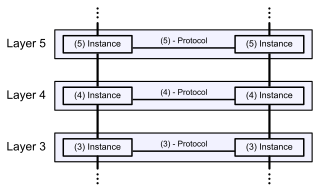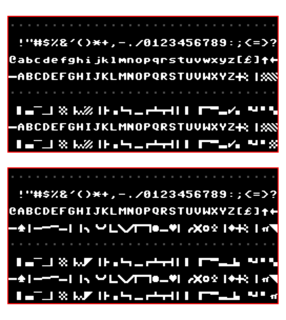 W
WThe Apple II is an 8-bit home computer and one of the world's first highly successful mass-produced microcomputer products. It was designed primarily by Steve Wozniak; Steve Jobs oversaw the development of the Apple II's foam-molded plastic case and Rod Holt developed the switching power supply. It was introduced by Jobs and Wozniak at the 1977 West Coast Computer Faire and marks Apple's first launch of a personal computer aimed at a consumer market—branded toward American households rather than businessmen or computer hobbyists.
 W
WThe Apple II series is a family of home computers, one of the first highly successful mass-produced microcomputer products, designed primarily by Steve Wozniak, manufactured by Apple Computer, and launched in 1977 with the original Apple II.
 W
WThe Atari 2600, originally branded as the Atari Video Computer System until November 1982, is a home video game console developed and produced by Atari, Inc. Released on September 11, 1977, it is credited with popularizing the use of microprocessor-based hardware and games stored on ROM cartridges. The VCS was bundled with two joystick controllers, a conjoined pair of paddle controllers, and a game cartridge: initially Combat, and later Pac-Man.
 W
WThe Color TV-Game is a series of five dedicated home video game consoles created by Nintendo that were released in Japan only. Nintendo sold three million units of the first four models: one million units of each of the first two models, Color TV-Game 6 and 15; and half a million units of each of the next two models, Block Breaker and Racing 112. The Color TV-Game series has the highest sales figures of all the first generation of video game consoles. The systems can run on C batteries or an AC adapter. It is also the first console to be released by Nintendo.
 W
WThe Commodore PET is a line of home/personal computers produced starting in 1977 by Commodore International. The system combined a MOS 6502 microprocessor, Commodore BASIC in read-only memory (ROM), a keyboard, a computer monitor and a cassette deck for data and program storage in a single all-in-one case.
 W
WCompucolor is a series of color microcomputers introduced by Compucolor Corporation of Norcross, Georgia. It was the first color home computer system with built-in color graphics and floppy-based data storage. It used the Intel 8080 CPU.
 W
WDECmate was the name of a series of PDP-8-compatible computers produced by the Digital Equipment Corporation in the late 1970s and early 1980s. All of the models used an Intersil 6100 or Harris 6120 microprocessor which emulated the 12-bit DEC PDP-8 CPU. They were text-only and used the OS/78 or OS/278 operating systems, which were extensions of OS/8 for the PDP-8. Aimed at the word processing market, they typically ran the WPS-8 word-processing program. Later models optionally had Intel 8080 or Z80 microprocessors which allowed them to run CP/M. The range was a development of the VT78 which was introduced in July 1977.
 W
WThe DECSYSTEM-20 was a 36-bit Digital Equipment Corporation PDP-10 mainframe computer running the TOPS-20 operating system.
 W
WThe Hazeltine 1500 was a popular smart terminal introduced by Hazeltine Corporation in April 1977 at a price of $1,125. Using a microprocessor and semiconductor random access memory, it implemented the basic features of the earlier Hazeltine 2000 in a much smaller and less expensive system. It came to market just as the microcomputer revolution was taking off, and the 1500 was very popular among early hobbyist users.
 W
WThe Hewlett-Packard HP-01 is a calculator watch. It was designed and manufactured by Hewlett-Packard (HP). The HP-01 used 7 light-emitting diodes (LEDs)/digit in a 7 digit + decimal point arrangement for its digital display. Introduced in 1977 at the height of the LED watch craze, five models were available, two gold filled models and three stainless models. Prices were from $450 & $550 for the low end steel or gold to $850. HP also sold a battery replacement kit that allowed the customers to change the batteries themselves. The watch uses two batteries for the display and one for the processor IC. It also comes with a ball-point pen with a stylus on the rear end. Most of the 28 buttons on the HP-01 are recessed, and are designed to be depressed with a stylus that is stored in the band. The production was stopped by the end of 1979.
 W
WIBM 5250 is a family of block-oriented terminals originally introduced with the IBM System/34 midrange computer systems in 1977. It also connects to the later System/36, System/38, and AS/400 and System i systems, and to IBM Power Systems systems running IBM i.
 W
WAn interactive kiosk is a computer terminal featuring specialized hardware and software that provides access to information and applications for communication, commerce, entertainment, or education.
 W
WThe MK14 was a computer kit sold by Science of Cambridge of the United Kingdom, first introduced in 1977 for GB£39.95. The price was very low for a complete computer system at the time, and Science of Cambridge eventually sold over fifteen thousand kits.
 W
WThe North Star Horizon was a popular 8-bit S-100 bus computer introduced in October 1977. Like most S-100 machines of the era, it was built around the Zilog Z80A microprocessor, and typically ran the CP/M operating system. It was produced by North Star Computers, and it could be purchased either in kit form or pre-assembled. The North Star Horizon was one of the first computers to have built in floppy drives as well as being one of the first computers to have a hard disk drive.
 W
WThe Open Systems Interconnection model is a conceptual model that characterises and standardises the communication functions of a telecommunication or computing system without regard to its underlying internal structure and technology. Its goal is the interoperability of diverse communication systems with standard communication protocols.
 W
WPETSCII, also known as CBM ASCII, is the character set used in Commodore Business Machines (CBM)'s 8-bit home computers, starting with the PET from 1977 and including the C16, C64, C116, C128, CBM-II, Plus/4, and VIC-20.
 W
WThe TRS-80 Micro Computer System is a desktop microcomputer launched in 1977 and sold by Tandy Corporation through their RadioShack stores. The name is an abbreviation of Tandy/RadioShack, Z80 microprocessor. It is one of the earliest mass-produced and mass-marketed retail home computers.
 W
WVAX is a line of superminicomputers and workstations developed by the Digital Equipment Corporation (DEC) in the mid-1970s. The VAX-11/780, introduced October 25, 1977, was the first of a range of popular and influential computers implementing the VAX instruction set architecture (ISA). Over 100 models were introduced over the lifetime of the design, with the last members arriving in the early 1990s. The VAX was succeeded by the DEC Alpha, which included several features from VAX machines to make porting from the VAX easier.
 W
WThe VAX-11 is a discontinued family of superminicomputers developed and manufactured by Digital Equipment Corporation (DEC) using processors implementing the Virtual Address eXtension (VAX) instruction set architecture (ISA), succeeding the PDP-11. The VAX-11/780 is the first VAX computer.
 W
WThe West Coast Computer Faire was an annual computer industry conference and exposition most often associated with San Francisco, its first and most frequent venue. The first fair was held in 1977 and was organized by Jim Warren and Bob Reiling. At the time, it was the biggest computer show in the world, intended to popularize the personal computer in the home. The West Coast PC Faire was formed to provide a more specialized show. However, Apple Inc. stopped exhibiting at the West Coast Computer Faire, refusing to exhibit at any show other than COMDEX that also had PC-based exhibits. In 1983, Warren sold the rights to the Faire for US$3 million to Prentice Hall, who later sold it to Sheldon Adelson, the owner of Interface Group and COMDEX. In total, sixteen shows were held, with the last in 1991. After Warren sold the show, it had a few more good years, and then declined rapidly.
 W
WThe Z notation is a formal specification language used for describing and modelling computing systems. It is targeted at the clear specification of computer programs and computer-based systems in general.